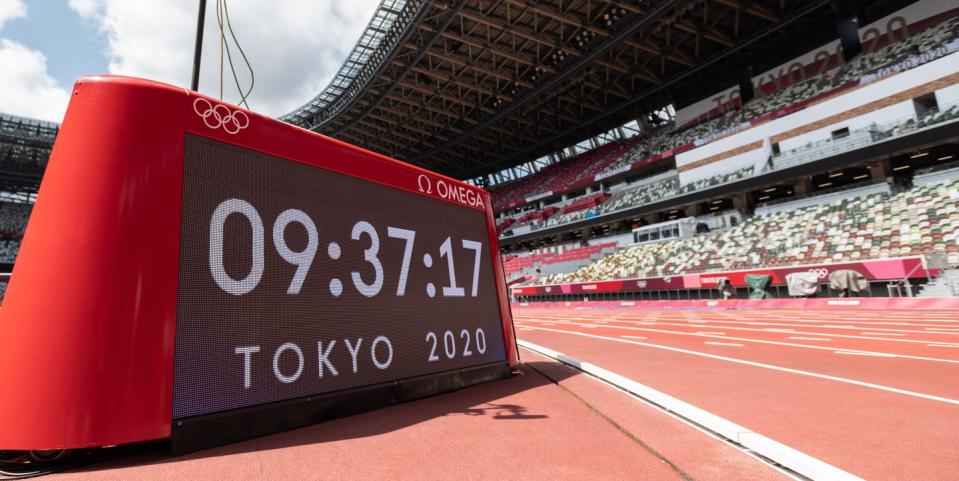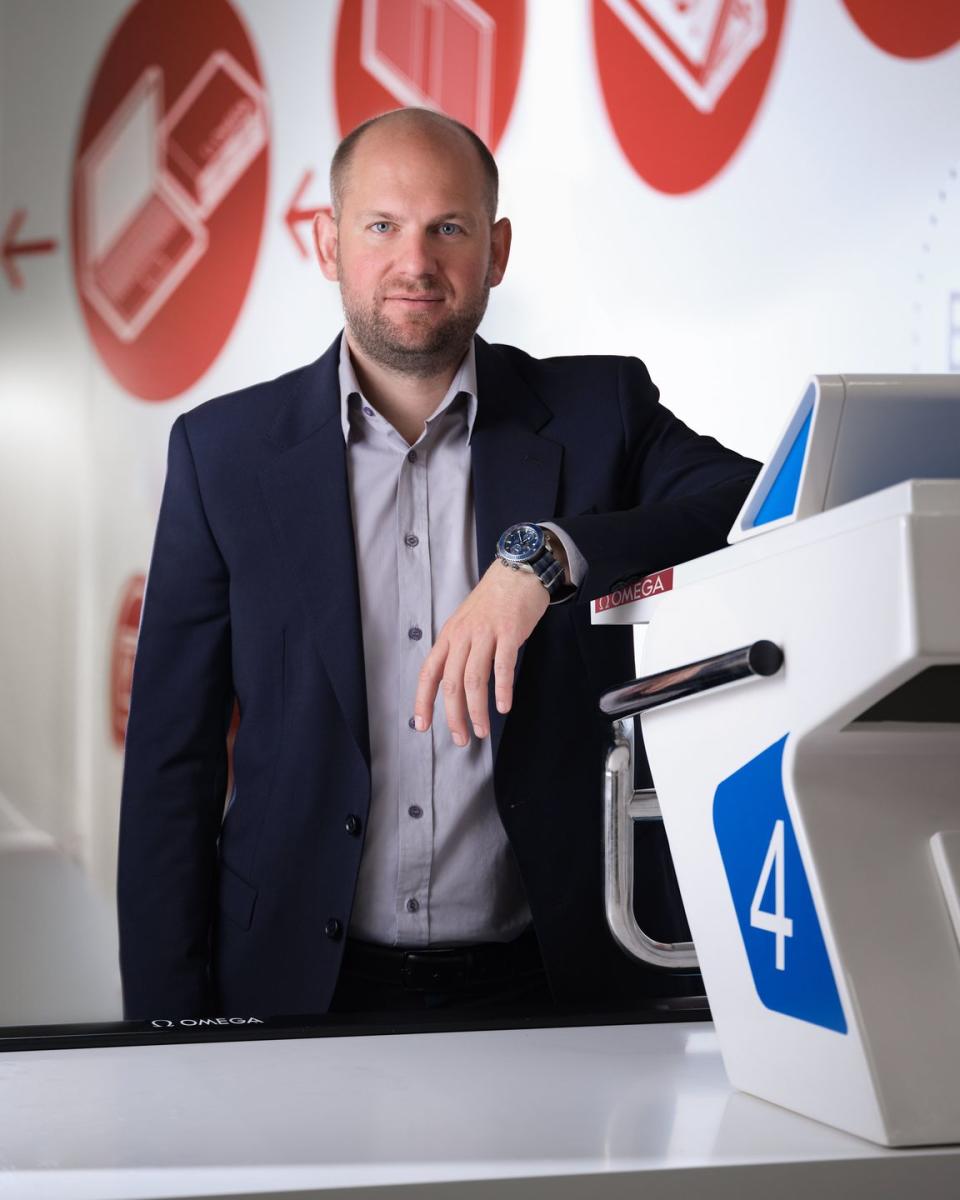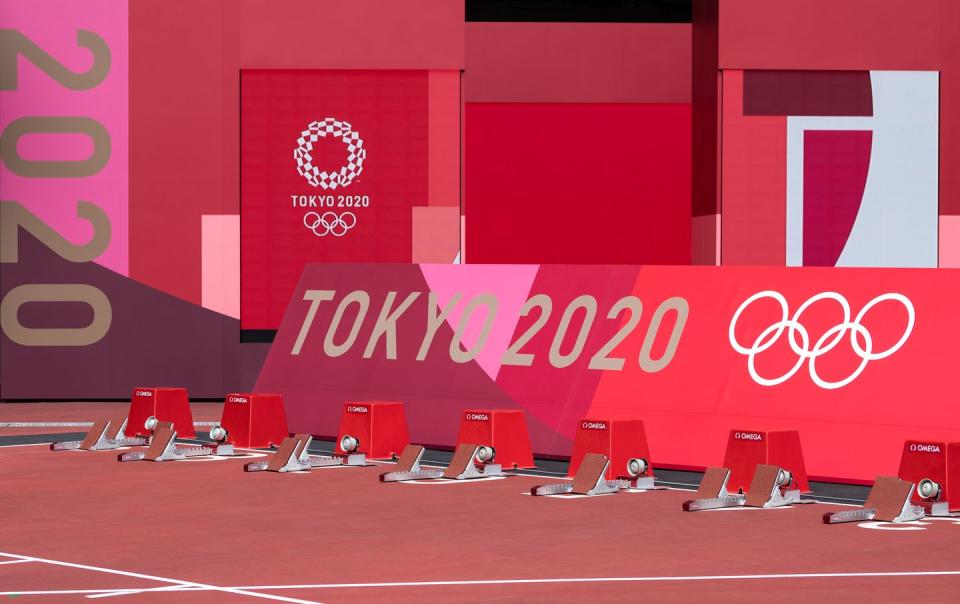The Man Who Times the Olympics

In 1932, Omega dispatched one watchmaker with 30 stopwatches to the Summer Olympics in Los Angeles. In London in 1948 the watch company produced the first photo finish equipment, allowing stewards to separate first and second place. In Mexico in 1968 the first touch pads were introduced by the company... and so it continues.
This summer marks Omega’s 29th time as the official timing and scoring partner of the Olympic Games, using equipment, sensors, cameras, positioning systems and other groundbreaking and record-making innovations it has developed alongside Swiss Timing, the technology company owned by The Swatch Group, Omega’s parent company.
For the Tokyo 2020 Olympic Games it has developed a raft of new tech. New motion sensing and positioning equipment now gives a more complete breakdown of each event, in real time, than has been possible. Meanwhile, new sports have brought new challenges: karate, surfing, baseball, skateboarding, climbing.
In total 339 events in 33 sports will be completed in Japan this year, and Omega is charged with recording every fraction of every second of every one.
Esquire spoke with Alain Zobrist, Head of Olympic Timing for Omega, about his role in the Tokyo 2020 Olympic Games.

What new timing equipment have you introduced for the Olympic Games Tokyo 2020?
We’ve introduced a few new technologies and innovations, with motion sensors and positioning systems. Those are certainly going to become part of Omega’s history in timekeeping. So far, we mastered everything related to the start of races and the finish of races. Now, with these new technologies, we’re able to measure the performance in between the start and the finish of athletes, and that’s groundbreaking. It’s very exciting to be able to share that information in real time to audiences watching the athletes, performing on TV through dedicated graphics.
How different is the timing now of say, the men’s 100m, compared to the last Tokyo Olympics, in 1964?
A lot of things have changed. Back then, we used much older versions of photo finish cameras. It took longer to measure the performance of the athletes. Today we have 10,000 pictures per second shot by these devices, giving us a very good understanding of who crossed the line first. That information is also given out immediately to the judges, and officials who then certify the results. So it’s certainly faster in terms of information provision.
In terms of false starts, a lot of things have evolved as well. In the last Tokyo Olympics false starts were detected visually. Today false starts are captured electronically. We have sensors in the back of the starting blocks that measure 2,000 times per second the horizontal pressure the athletes put on the block. The reaction of the athlete is measured by the increase in pressure and if that reaction is more than 1/10th of a second after the gunshot the start is valid. If it's less than 1/10th it’s counted as a false start, according to the rules of the [Olympic] International Federations. We have a new timing device as well which is capable of measuring up to a millionth of a second.
Those devices were obviously performing with a much lower resolution, back in the day. Athletes are our primary stakeholders. They’re the ones we’re doing all of this for. They’re the ones who train for years to be able to compete at the Olympics and they deserve to have the most advanced and sophisticated timekeeping equipment, operated by the best timekeepers - in order to be able to provide them with their results.

How many timekeepers are involved this year?
Five hundred and thirty timekeepers travelled to Tokyo. The first ones arrive mid-July, roughly 10 days prior to opening ceremony. In order to be ready for a start of the competition.
A question on gymnastics. There's a lot of data being captured. Does that make the judges' job more complicated?
No, it makes the scoring process better by analysing so much more. The horizontal displacement technology that we use for trampoline actually replaces the judge. The device allows us to understand where on the trampoline the athlete lands. According to the rules of the Federation, if the athlete lands out of the red square in the middle of the trampoline then there are deductions of points to their final score. The computer vision and the artificial intelligence used for that automatically deducts points from the athletes final result. And as a consequence they eliminate all mistakes that could be made by humans, and differences that the human eye could could not see. So it will not slow the process, it will actually speeds it up and make it more accurate, and also more fair to athletes.
What has been the biggest evolution in Omega’s partnership with the Olympics?
That’s a big question. It started in 1932, and we have renewed our contract until 2032 which will mark the 100 year anniversary as timekeeper for the Olympic Games. There’s so much that has happened in those almost 100 years now. It started with one watchmaker with 30 coronagraphs back in 1932. We had a lot of pioneering a new technologies that were introduced, all the way through. Now we’re in Tokyo with 530 timekeepers deploying 400 tonnes of equipment. The evolution is right there. We’re not working with manual chronographs anymore. We’re working with sophisticated computers and systems that are tailor-made for every single sport’s needs.
Our role and responsibility however, has not changed. We’re still committed to provide all results to all athletes participating, as soon as they finish their race. The latest change is really the introduction of our motion sensors and conditioning systems that will be a game-changer for sports overall. We will be able to compare performances of athletes in a way that was never able to be done before.
Nowadays, timekeeping is considered as something normal. No one really questions how it all works. Now, put yourself in the seat of the timekeeper who about to measure the results of the athletes participating in [for example] the 100 metres final. And, as a timekeeper, you know that you’ve got billions of people watching that race, that they will want to have the results of the athletes as soon as they cross the finish line, and that they know that you cannot make any mistakes, because as soon as you hit that enter button to send the result of the athletes, there is no way back. So there is tremendous pressure on the team.
Hopefully as official timekeeper our engineers and our timekeepers are very skilled. We’re used to those kinds of situations. But probably people do not realise what it takes to provide these results of the actions. And you may have seen it in a movie, right? Where it takes 20 minutes with the first photo finish cameras to get a result! Today everything is live and instant. It takes us less than 1/100th of a second to measure and publish your results in swimming. That's fascinating.

How do you mitigate for technical electronic failures on day?
Well, firstly our systems are backed up. So we have up to two or three backups, and backups of backups, installed in all sports. And that means that we can shift from the main system to a backup system, instantly, during a competition, if an issue occurs – without losing any information or the performance of the athletes. And we have these backups everywhere. But obviously, they're a combination – or teamwork, if I may say so – between the machine and the human, and it needs to be perfect.
So, on one hand the devices that are deployed are thoroughly tested, and also used in over 500 competitions per year. But also our timekeepers are trained, not only by operating the systems and all those events I just mentioned, but also in our labs where we train how to troubleshoot, in case an issue occurs. So, of course there is no 100 per cent guarantee that everything works. But we do everything to keep the combination between the machine and our timekeepers absolutely accurate and working perfectly well during the games, or at any other sports event.
Do you have a favourite Olympic moment?
I remember at the Olympics in Sochi [2014]. In the women's downhill race [Alpine skiing] two athletes won the gold medal. Both skiers, Tina Maze [of Slovenia] and Dominique Gisin [Switzerland] had exactly the same time. This is quite unique in downhill alpine skiing if you consider the length of the run, around two kilometres, and it takes around one and a half to two minutes depending on the slopes. And then the athletes usually have different conditions because it’s an outdoor sport. So to have two athletes, finishing in the same 100th of a second was quite fascinating, and a great moment for me personally.
What keeps you awake at night?
I usually sleep very well, because I have a lot of confidence in my team. And in the equipment that we deploy. Nothing that keeps me awake at night.

Do you breathe a sigh of relief after the Games?
No. After the Games is before the next Games. There is no time for relief. Six months after the closing of the Paralympics, more or less, we will serve as a timekeeper with the Winter Olympics in Beijing. So we’ve got no time to rest. One follows the other. And we’e very much looking forward to going to Beijing as well.
What’s your personal favourite event?
From a timekeeping perspective my favourite event to watch is athletics. That to me is the most interesting one because it’s also the most complex. A lot of things happen at the same time. We have a track event going on. And at the same time the technical disciplines long jump, triple jump, high jump or javelin or whatever. And that requires the deployment of [lots of different] equipment, all those different events going on in parallel and timekeepers who operate those systems in parallel. Everything needs to be synchronised with the timekeeping, and with the data handling. The complexity of those topics is fascinating to me. And from a timekeeping perspective, it’s certainly the most complex
You Might Also Like

 Yahoo Finance
Yahoo Finance 